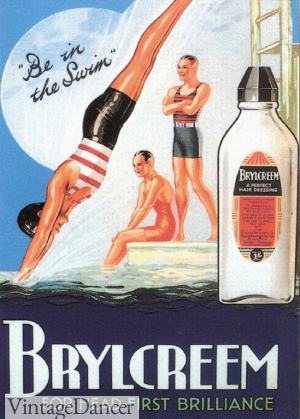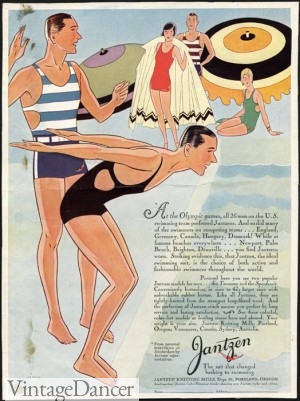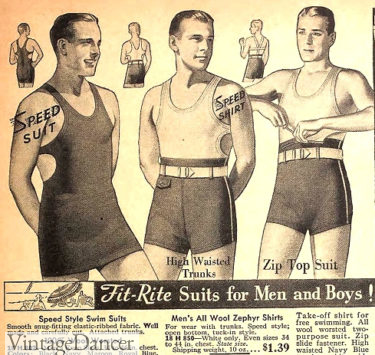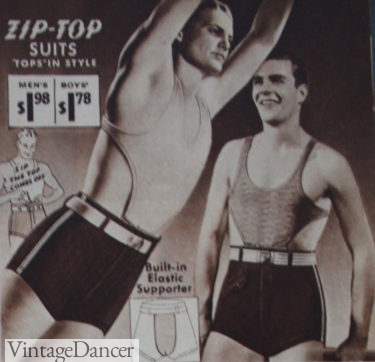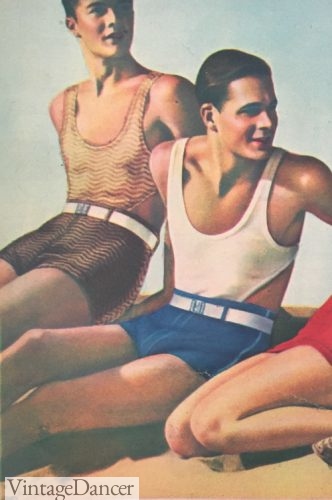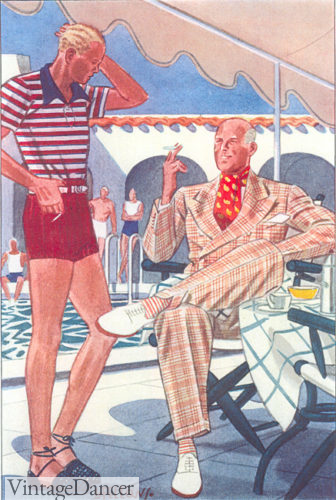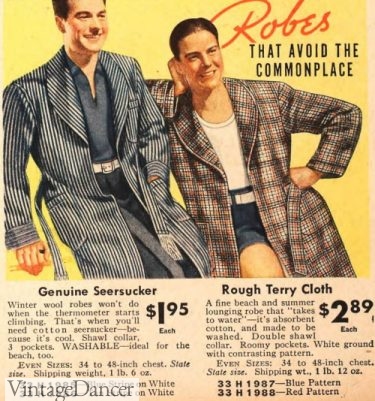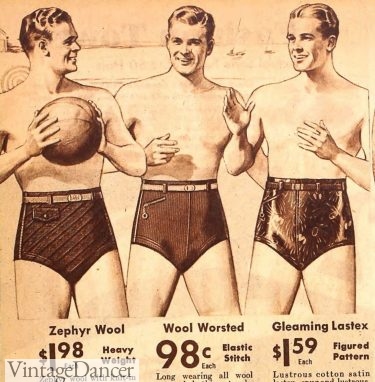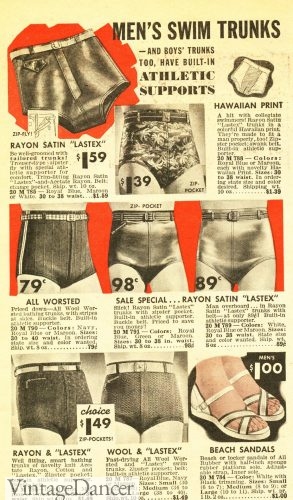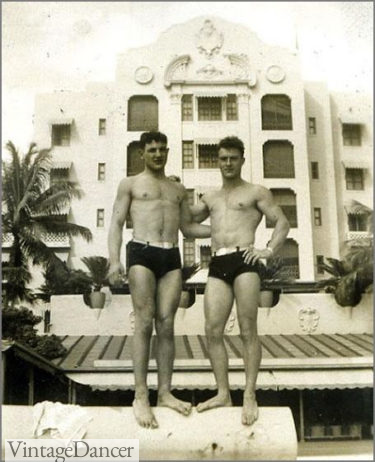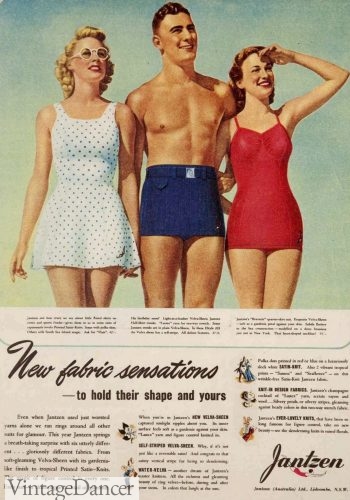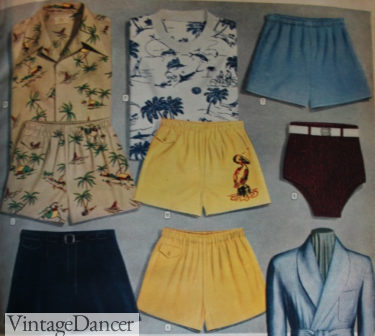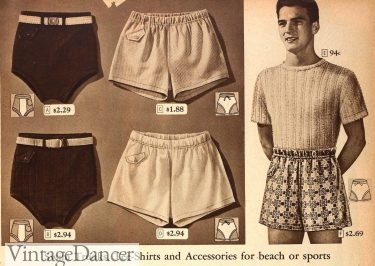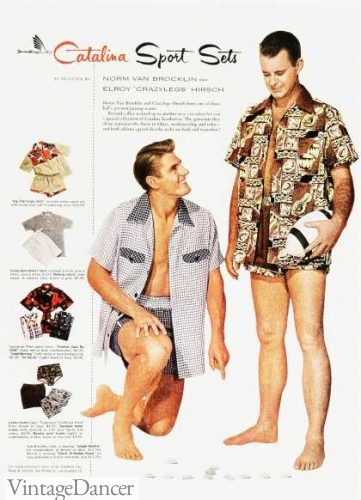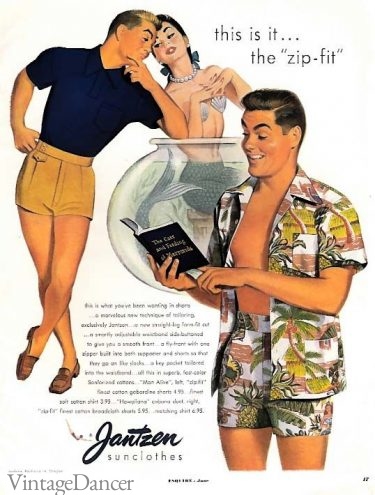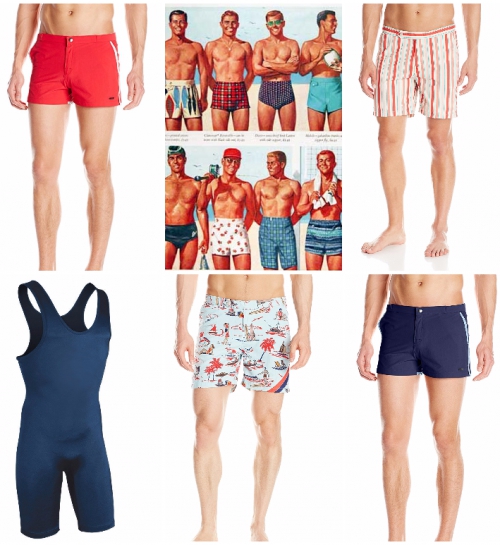What did men wear to the pool or beach in the 1930s, 1940s, and 1950s? Vintage men’s swimwear experienced big changes over the course of 30 years. From the unitard look of the 1930s to the wool swim brief in the 1940s ending with the classic boxer shorts of the 1950s. Some of these men’s vintage bathing suit looks are back in style while others are still antiques from the past.
Let’s take a brief look at vintage men’s swim suits by decade. The article looks at 1930s to the 1950s. For the 1920s look here and for the 1960s to 1980s look here.
Shop –> vintage retro swim trunks
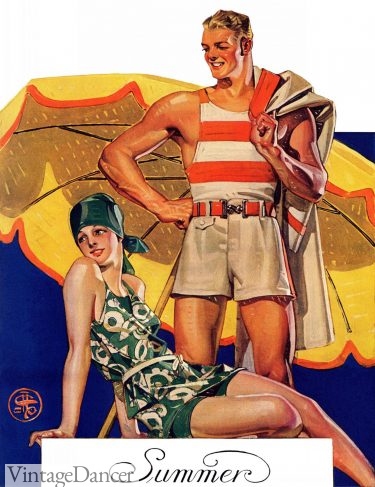
1937 swimwear (J. C. Leyendecker art)
1930s Men’s Swimwear
While the men’s 1920s swimsuit was a one-piece long tank top over attached shorts, the 1930s embraced the change to two piece swimsuits. The ideal Superman body of the 1930s made a man’s torso something to show off at the pool or beach. “Crab back” tops were cut wide around the neck, arms and waist providing minimal coverage to the chest.
Wide horizontal stripe tops were in colors of brown and yellow, yellow and blue, red and tan, black and gold, blue and white, and green and gray made swimwear stand out on the beach.
Instead of them being a unitard as they were in the 1920s, the “twosome” bathing suit zipped, snapped or buttoned onto the inside of the shorts, giving the look of a one-piece swimsuit. The shorts had an attached supporter (narrow briefs) sewn into the waistband. Some shorts had a false fly front. Marron was the trendiest new color in swim shorts.
- 1930 men’s stripe top swimsuit
- 1930- Men’s Suits were getting smaller but still all in one pieces
Solid colors of blue or black were the most common shorts colors. A white cotton belt with metal clasp held the shorts in place. As the decade progressed, shorts became shorter, rising into a high-waisted brief and fit with a little less room in the front.
- 1935 Old and NEw Style Men’s Swimsuits
- 1937 mens swim shorts with detachable top
- 1937 Swimwear
For men who were not quite so bold as to wear a very fitted knit swimsuit, could wear the shorts style with attached top. Shorts fit like men’s trousers with a high waist, button fly, and a small coin pocket on one side. A white or colorful belt held the shorts up. They were made of wool flannel instead of knitted wool.
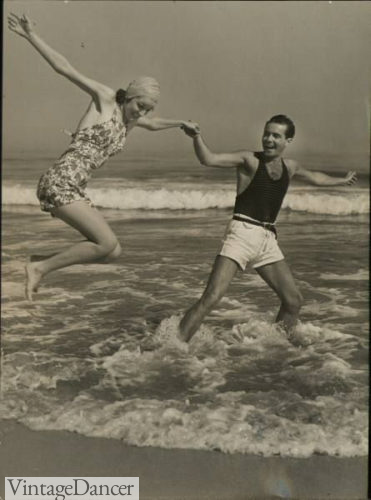
Top and bottom swimwear set
When not swimming, men would wear a coordinating polo shirt around the pool or resort. Flannel, seersucker and terry cloth short robes were another throw over option. They could be solid colors, horizontal wide stripes, plaid or tropical prints. A pair of white flannel trousers could also be worn over bathing suits.
- 1930s red swim trunks with white belt and striped polo shirt
- 1938 seersucker and terry cloth beach robes
1940s Men’s Swimsuits
In the 1930s, men’s two piece swimsuits were loosing favor. Men were removing the top and wearing only the brief, especially in Europe where modesty wasn’t as serious as it was in America. By the end of the decade retailers were catching on to the trend and selling swim briefs without tops.
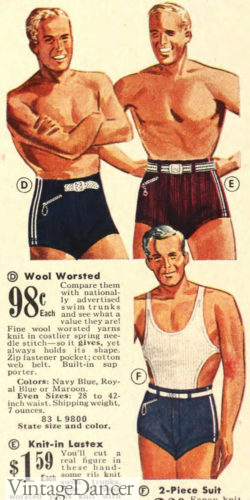
1939 swim briefs with and without the swim top
Most swim briefs were made of worsted or Zepher rib-knit wool. However, rayon ‘Lastex’ fabric, which utilized spandex for stretch (and dried much faster than wool!), was coming into use, eventually replacing wool and cotton altogether. Rayon-Lastex had shine like satin or could be matt and textured like knits. While most shorts were a plain solid color some featured Hawaiian prints or subtle plaids and checks. Royal blue was the newest color with maroon, navy blue and green being the other choices.
Swim briefs were very high in the waist and had low-cut legs as well. Some were worn with white cotton belts while others had a wide knitted waistband, inside drawstring or elastic gathered waistband (after the War.) Most had a small coin pocket on one side that buttoned or zipped close.
- 1941 swim briefs of wool or Lastix blend
- 1940 swim briefs (top right has a Hawaiian print!)
- Mid 1940s swim briefs
- Half-skirt trunks
There was one style of swimsuit called a “half-skirt trunks” that appeared in the early 1940s. It was literally a very short skirt with a pair of briefs sewn into the band. The skirt was so short the brief’s were visible. Too immodest for most Americans they were more often seen in European or in the gay community. Hawaiian prints on a white ground made these swim shorts extra fun to wear. Solid colors with white briefs called attention to what was under the skirt. They came back in fashion in the 1950s.
In the later years, brighter colors such as yellow, red, lime green, orange and white were added to the swimsuit mix.
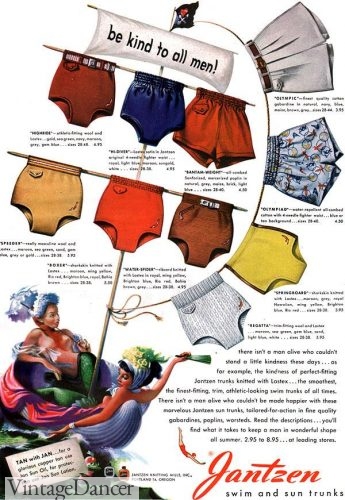
1948 men’s swim briefs
Swim trunks were rising in popularity during the late ‘40s. The shorts were made with cotton and had an elastic waist. They were also worn with a high waist and were cut straight, coming to mid-thigh. Trunks were usually in the same colors as briefs but were also made in loud tropical prints and nautical motifs. They were worn with a matching short-sleeved button-up shirts later called a Cabana shirt, and cotton or terry cloth T-shirts.
- 1947 swim shorts with matching shirts
- 1946 swim trunks and briefs with terry cloth shirt
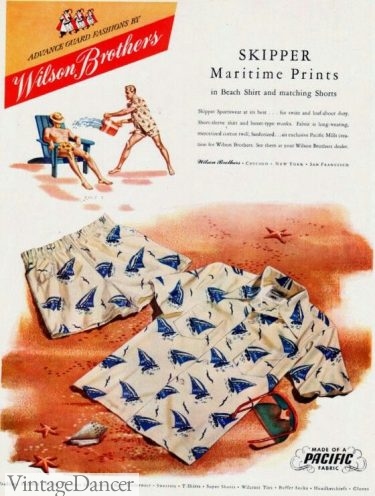
1947 matching “cabana set” in a sailboat prints
1950s Men’s Swim Trunks
In the early 1950s, high waist brief style swim shorts were still in fashion. Belts were gone but wide gathered elastic waistbands were in place. Built in supporters were attached to both brief and boxer types. Separate brief style swim supporters could also be purchased.
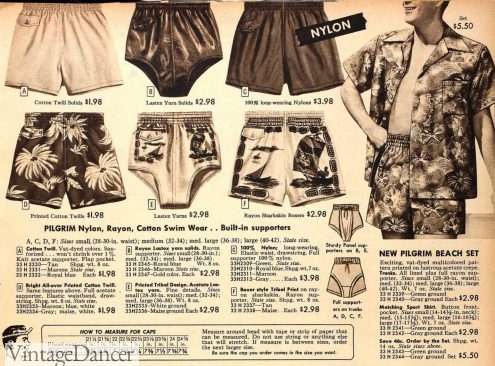
1952 elastic waist swim trunks and brief in plain or tropical prints
Oddly enough, Americans were behind the time in men’s swim fashion. Beachside rules kept men in modest swimwear while European, Hawaiian, and Caribbean cultures embraced the French bikini. It was a 1930s style tight brief with a high cut leg and below the navel waistband. The “Speedo” of the 1950s. In America, few men choose these suits except gay men. Elsewhere, they were considered normal for every man.

1950s mens swim trunks, briefs, boxer, and shorts varieties
The swim boxer / trunk became the most common swimwear for men in the ’50s. Leg lengths extended down a few inches or down to the knee (swim-walkers.) The idea was they looked like men’s walking shorts so that they would be worn with a matching shirt at any beachside resort and not be under-dressed.
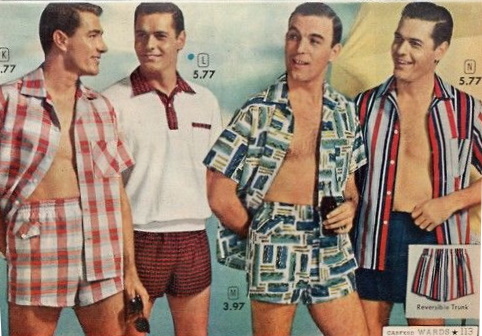
1958 men’s swim shorts and shirts
Some swim shorts had zipped flys and a small inside pocket. Outer coin pockets continued to be placed on all styles of swimwear. Some had a flat waistband with tab button band which was a nod back to sport shorts in the 1930s. Others had half belts across the front, side zippers, or inside drawstrings.
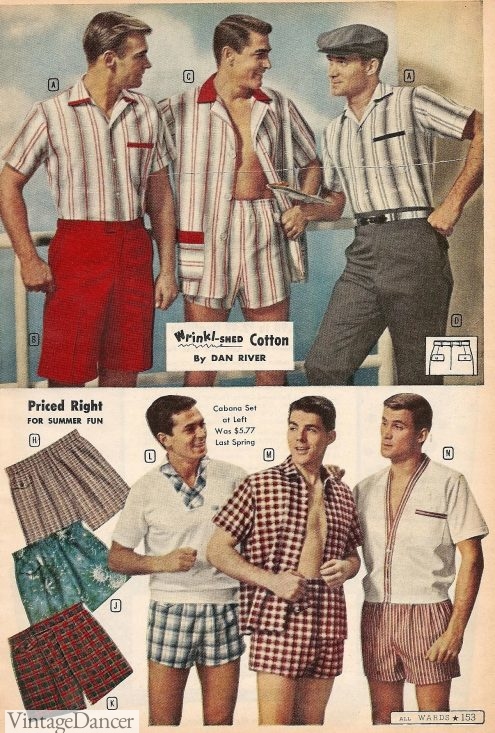
1959 mens shorts and swimsuits with shirts
The variety or waistband treatments, lengths, and fit complimented the multitude of colors and patterns. While previous decades favored solid colors, the 1950s wanted prints.
Tropical prints, novelty prints, geometric prints, “Atomic Art,” sea life (sea horse, sea shells, palm trees, vacation destinations) as well as small plaids, checks, gingham, and vertical stripes. Loud Caribbean colors such as teal blue, yellow, red, sea green, and white made it difficult to go unnoticed.
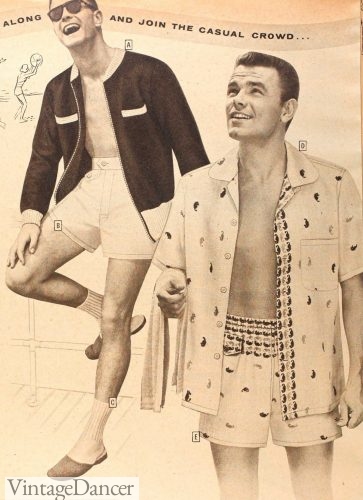
1955 tab button waistband and novelty swim trunks with shirt and jacket
As a cover-up, matching cabana shirts continued to be sold with swim trunks. These tropically themed, plaid, striped or novelty print sport shirts gave men an opportunity to leave their grey flannel suits at the office and enjoy life in more color at the beach.
- Cabana sets
- Cabana shirt (polo shirt in the back)
Buy vintage style men’s swimwear
If you don’t want to wear genuine vintage swimsuits (wool=itchy), there are some options for new, vintage inspired swim trunks. The current styles favor the ’60s and ’70s with boxer style and hip hugger shorts. A few brands are making short shorts with button waistbands instead of a drawstring. Sadly, almost no one is making high rise ’30s to ’50s swimming trunks and briefs. You could commission one to be hand knitted by Vintage Stitches Historical Knitting (UK)
For 1920s and 1930s one-piece swimsuits, consider a singlet (wrestling suit) instead. You could also pair a long tank top with biking or yoga shorts together for a two-piece look. You could attach them together with snaps to keep the top from floating up in the pool.
Most modern swim trunks could work for a ’50s look if you remove the drawstring. They will not be high waisted. The better choice is to have a fitted waistband instead of elastic. Look for fun retro prints or classic solid colors with matching cabana shirts. Cabana sets are back in fashion this year (Yessss!)
Here are some options for 1920s to 1990s swimwear styles:
Debbie Sessions has been teaching fashion history and helping people dress for vintage themed events since 2009. She has turned a hobby into VintageDancer.com with hundreds of well researched articles and hand picked links to vintage inspired clothing online. She aims to make dressing accurately (or not) an affordable option for all. Oh, and she dances too.
